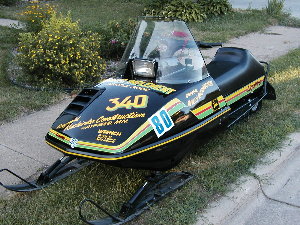The Limited Edition Racing Machines

During the height of the snowmobiling era, and after a couple years of sled production, John Deere jumped in the racing game. They built several limited edition models, all of which were also functional trail sleds. The first was the 295/S.
The 1974 295/S was based on the chassis and design of the previous 00 and JDX series. The big difference was the motor, the Kioritz KEC-295RS/2. This lightweight was the first Deere to have dual Mikuni carbs, CDI ignition, and a performance exhaust. It was available with a 2 gallon center mounted gas tank (where the glove box normally was) or the normal 5 gallon front tank. There was also a choice of suspensions including the 00 series bogie wheels with solid track, the JDX type slide suspension with cleated track, or even a slide/bogie combination with the solid track which was not used on any other models.
The Bogie/Slide suspension:

The next was the 1975 340/S. This sled featured an entirely new chassis design which Deere needed badly to compete. It held a Kiroitz KEC-340RS/2 fan cooled motor that was moved forward, and lower in the chassis. It also used a center mounted fuel tank, some with duel fill caps so it could be fueled from either side at a pit stop.
Next, the famed 1976 Liquidator. This sled was based on the 340/S chassis, but now had a liquid cooled version of the 340RS. They added a distinctive scoop on the hood to help cooling, among other performance upgrades. A rear fuel tank was made available to fit in the back of the seat. These machines were very heavy compared to the sleds of the day, but handled well. In '77, racers were able to purchase an update kit, which reduced the weight, mainly due to a replacement rear skid and a lightweight hood.

The last limited edition model was the 1978 Cross Country Liquifire. The Cross Country was a very stock looking 78 340 Liquifire, including the normal KEC-340/23LC motor. It had a restrictive factory exhaust manifold on it to keep the power down to 45 hp, per the rules that year. You can easily identify the manifold, as it has a piece of flat steel rectangular steel welded on the top side, down by the ball joint. If you look into it from the ball joint end, you can see the extra piece of tubing welded into the inside. The track was a rubber Yokohma unit that looks just like the 80 LF track, only longer. 3.29 drive pitch, triple drive sprockets. The suspension looked a bit like an 80 LF unit, with center idlers.